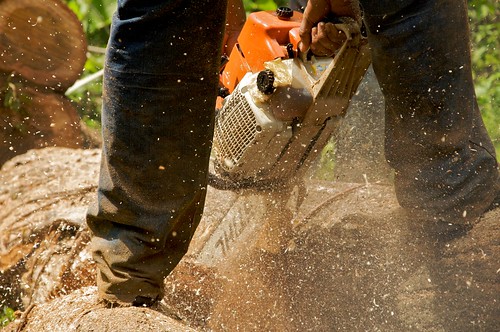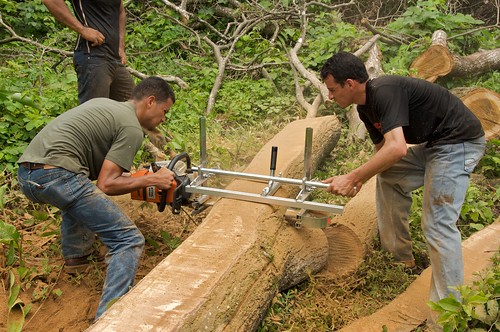Turning the guayacan log into slabs
In the previous post I described how we found the guayacan tree and how it got prepared. This time you can see how it gets cut into slabs. From those slabs we make poles in another step.
But first a thick branch on the main trunk has to go. I like this picture because it shows very well how the sawdust flies around the operator. This is really hard work and Moises does a good job.
<div style="text-align:center;"> </div>
</div>
Now it is time to attach the Alaskan Mark III sawmill extension to our Stihl MS 650 chainsaw. This contraption is actually a very smart invention. There are many cases where you need sawn wood but the wood and the use for it is in a location that’s too remote to first drag logs out and then bring the sawn wood back in. There are portable sawmills but none of those you can put on horseback. Those devices are trailers to be towed behind a light truck.
<div style="text-align:center;"> </div>
</div>
With the Alaskan Mark III the chainsaw slides through the log creating a slab. For the first cut you use some rails to give it an even surface to slide on. All further cuts depend on the quality of the first one. We did learn our lessons and have since moved from a very weak set of rails to a better version. But for marker poles it was fine.
Luis is driving a small stick into the opening to help the blade not getting stuck.
<div style="text-align:center;"> </div>
</div>
The guys took turns driving the chainsaw. The guayacan is so hard that it takes about half an hour to cut just one slab.
<div style="text-align:center;"> </div>
</div>
In the end we got the slabs we wanted. They get put aside after each run through the log.
<div style="text-align:center;"> </div>
</div>
| Previous | 27 Nov 2009 | Next |
This article has been posted to social media sites. There might be comments. Just follow the links:








